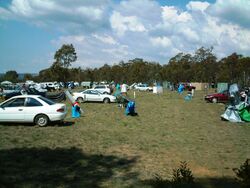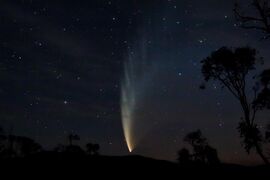Organization:Astronomical Society of New South Wales
 | |
| Abbreviation | ASNSW |
|---|---|
| Formation | 1954 |
| Legal status | Incorporated association |
| Location | |
Membership | Over 400[citation needed]. |
| Publication | Universe Magazine |
| Website | www |
The Astronomical Society of New South Wales (ASNSW) is an amateur astronomy club in the state of New South Wales, Australia , founded in 1954.[1]
The society's objectives, as stated in their constitution, are to "bring together people interested in astronomy and related sciences, and to promote public interest and education in astronomy. The ASNSW provides members and the general public access to Astronomical observing facilities, educational lectures, and assistance in selecting, using and even building telescopes and related instruments".[2]
The ASNSW has many sections dedicated to providing support to members interested in specific aspects of astronomy, including astrophotography, computing, solar observing, the Solar System, double and variable star observing, deep sky observing and telescope making. The society also runs two dedicated observing sites; one at Mount Bowen near Sydney, and the other near Ilford.
History
The society was founded in 1954 as the "Sydney Amateur Astronomers" by Gordon Patston, an aerospace engineer lecturing at Sydney Technical College. The club started with about fifteen members with Patston as the president. The first meetings were held in the garage behind Patston's house in the suburb of Belfield.[3]
As the group attracted new members, it became too large for the garage, resulting in a permanent clubhouse being constructed within the Patston family backyard. The majority of work was done by club volunteers, and on the 18th of September 1959, the new facility was officially opened by the astronomer, Bart Bok, the then Director of Mount Stromlo Observatory.
The club was very active through the late 1950s and 1960s, with general-interest events such as public open nights and sections for special purposes such as a junior section. It also worked with professional observers on a number of research projects, including a flare star observing program at the request of the CSIRO and the measurements of transits of artificial satellites across the moon as part of the Smithsonian Astrophysical Observatory's "Project Moon-watch".[4](p85) A program for observing artificial satellites was set up at shortly after the launch of the Sputnik satellite on 4 October 1957. The club was the first group in the world to see the first artificial satellite, Sputnik I, in October 1957[5] and they went on to record three of the first four Sputnik observations.[3][6]
In 1964 the society's name was changed to the "Astronomical Society of New South Wales", to better reflect the scope of its membership.
In 1969/70 the Society suffered two major setbacks. First, the Society was forced to sell its headquarters when the Council re-zoned and subdivided the Patstons' block of land. Second, the Society lost its president when Gordon Patston moved to England to take up a Churchill Fellowship to study aerospace engineering. The combination of events caused financial hardship for the club, and the lack of a permanent venue initially made it difficult to attract and retain members. At its lowest point in the mid-1970s, membership numbers dropped to less than fifty.[7]("Ken Wallace") It took nearly ten years to build membership back up to previous levels.[3]
In 1973 the society acquired a long-term lease from the government for the Crago Observatory site on Bowen Mountain, but in spite of being used regularly, the official inauguration was not held until 20 years later, in 1993. Then in 1987, the society purchased the Wiruna property near Ilford, to get away from the increasing glare of the city lights which interfered with observing.[4](pp87,88)
In 1985 the society was incorporated under the Associations Incorporation Act.[8] The society was an early adopter of computer and communications technology, establishing their website in April 1995.[4](p87)
Activities
Meetings
The society normally holds two general meetings each month.[9]
South Pacific Star Party

Starting in 1993, the "South Pacific Star Party" (SPSP) is held each year at the Society's dark-sky observing site "Wiruna", attracting between 200 and 400 Australian and international amateur astronomers.
Publications
- UNIVERSE is the journal of the Society, published monthly since June 1964.
Observing facilities

The Society has two main observing sites where regular observing sessions are held for its members and guests:
- Wiruna (Aboriginal for "Sunset") is a 43 hectares (110 acres) site about 14 km outside the country town of Ilford, 220 km north-west of Sydney. The site has general observation facilities, a large hall and amenities, and it is the venue for the annual South Pacific Star Party.
- Crago Observatory is a permanent observatory housed in a rotating dome, located on Bowen Mountain, within the Blue Mountains National Park near Richmond.
Both of these sites are classified as "designated optical observatories" (numbers D03-41 and D03-50) by the Astronomical Society of Australia on the basis that they are judged to be valuable astronomical resources for research, education and community use.[10]
Notable members' achievements
Three members of the society listed below have collectively discovered well over 500 comets, asteroids (minor planets), and novae.[11][12]
- Robert Evans holds the world record for the number of visual discoveries of supernovae by an individual amateur; (As of January 2009), his total came to 42 visual supernova discoveries plus one comet.[11] Supernova 1983N, spotted by Evans in 1983 in the galaxy M83 long before it reached its peak, turned out to be the first discovery of a new type of supernova, later named Type 1b.[13] His efforts have been recognised by the American Association of Variable Star Observers awarding him their Nova/Supernova Award fifteen times,[14] the Astronomical Society of Australia awarding their Berenice Page Medal in 1986[15] and the ASNSW the McNiven Medal, in 1996.[7] He received the Order of Australia in 1988 for his contributions to science.[16]

- Robert McNaught has been described as "the world's greatest comet discoverer"[17] – he is a prolific discoverer of both asteroids and comets; (As of June 2014), the International Astronomical Union lists him as the discoverer of 458 minor planets,[12] and NASA lists 72 comets and asteroids bearing his name.[18] He is perhaps best known to the public for his discovery of comet C/2006 P1, also known as the "Great Comet of 2007", which was the second-brightest comet since reliable records began.[19] He is involved in the search for Near Earth Asteroids. He was first to photograph Supernova 1987A in the LMC. His close association with the ASNSW over many years includes delivering the guest lecture to the South Pacific Star Party, and he was awarded the Society's McNiven Medal, in 1997.[7]
- Gordon Garradd has been a diligent and productive discoverer of asteroids, supernovae and novae for nearly a quarter of a century; (As of June 2014), the International Astronomical Union lists him as the discoverer of 30 minor planets.[12] Mr Garradd has an asteroid named after him, 5066 Garradd,[20] and also sixteen comets are named after him,[21] including C/2009 P1[22] which became well known in 2012 when it was photographed by the Deep Impact (spacecraft) spacecraft.[23] He went beyond discovering these objects by also finding their astrometric positions, and he is also recognised for his search for Near Earth Asteroids using CCD imagery. He discovered four novae in the Large Magellanic Cloud (As of 1998). Mr. Garradd was recognised in 1998 with the presentation of the Astronomical Society of Australia's Berenice Page Medal.[15] He joined the Astronomical Society of NSW in 1974, and he was awarded the Society's McNiven Medal, in 1998.[7]
- The society's Sydney Moon-watch station was the first group in the world to observe the first artificial satellite, Sputnik 1, in October 1957[5] and went on to record three of the first four Sputnik observations.[6]
See also
References
- ↑ "History" Astronomical Society of NSW. Retrieved October 27, 2023.
- ↑ "CONSTITUTION of the Astronomical Society of NSW Incorporated". Astronomical Society of NSW. 5 May 2014. http://www.asnsw.com/sites/default/files/Constitution2014.pdf.
- ↑ 3.0 3.1 3.2 Flavin, John. "Gordon Patston – Founder of the ASNSW". Astronomical Society of NSW. https://www.asnsw.com/history.
- ↑ 4.0 4.1 4.2 Bryant, Greg (February 1999). "Astronomy Under the Southern Cross". Sky & Telescope 97 (2): 84–89. Bibcode: 1999S&T....97b..84B.
- ↑ 5.0 5.1 "Astronomy for Amateurs". The Age. 3 June 1969. https://news.google.com/newspapers?nid=1300&dat=19690603&id=DxdVAAAAIBAJ&pg=5208,230544.
- ↑ 6.0 6.1 Campbell, Leon from the Optical Satellite Tracking Program of the International Geophysical Year, cited in Bryant, Greg (February 1999). "Astronomy Under the Southern Cross". Sky & Telescope 97 (2): 85. Bibcode: 1999S&T....97b..84B.
- ↑ 7.0 7.1 7.2 7.3 "The ASNSW McNiven Medal". Astronomical Society of New South Wales. http://www.asnsw.com/node/753.
- ↑ "About the ASNSW". Astronomical Society of NSW. http://www.asnsw.com/node/9.
- ↑ "Meetings And Events". Astronomical Society of New South Wales. http://www.asnsw.com/node/10.
- ↑ "Designated Optical Observatories". Astronomical Society of Australia. https://asa.astronomy.org.au/membership/observatories/.
- ↑ 11.0 11.1 Smith, Bridie. "Sky the limit on galaxy quest". The Age (Melbourne). http://www.theage.com.au/national/sky-the-limit-on-galaxy-quest-20090109-7dp0.html?skin=text-only.
- ↑ 12.0 12.1 12.2 "Minor Planet Discoverers". International Astronomical Union. 15 June 2014. http://www.minorplanetcenter.net/iau/lists/MPDiscsNum.html.
- ↑ Evans, Rev. Robert. "Searching for Supernovae: A More Personal Story". http://revivals.arkangles.com/searchingforsupernovae.php. "This page is an extract from Rev. Robert Evans' upcoming book "Searching for Supernovae"."
- ↑ "The Nova/Supernova Award". American Association of Variable Star Observers. http://www.aavso.org/novasupernova-award.
- ↑ 15.0 15.1 "The ASA Berenice Page Medal". Astronomical Society of Australia. http://asa.astronomy.org.au/page.html.
- ↑ "Search Australian Honours: EVANS, Robert Owen". Australian Government. 26 January 1988. https://honours.pmc.gov.au/honours/awards/886182.
- ↑ Mobberley, Martin (2011). Hunting and imaging comets. New York: Springer. p. 75. ISBN 978-1-4419-6905-7. https://books.google.com/books?id=qU95h4yKia4C&pg=PA103.
- ↑ "JPL Small-Body Database Browser search for "McNaught"". NASA Jet Propulsion Laboratory. http://ssd.jpl.nasa.gov/sbdb.cgi?sstr=McNaught.
- ↑ "Brightest comets seen since 1935". Harvard. http://www.icq.eps.harvard.edu/brightest.html.
- ↑ "JPL Small-Body Database Browser on 5066 Garradd". Jet Propulsion Laboratory. http://ssd.jpl.nasa.gov/sbdb.cgi?sstr=5066+Garradd.
- ↑ "JPL Small-Body Database Browser search for "Garradd"". Jet Propulsion Laboratory. http://ssd.jpl.nasa.gov/sbdb.cgi?sstr=Garradd.
- ↑ "In the Sky This Month – July 2009". Comets. July 2009. http://transientsky.wordpress.com/2009/07/04/in-the-sky-this-month-july-2009/.
- ↑ Farnham, Tony; Bodewits, D.; a'Hearn, M. F.; Feaga, L. M. (October 2012). "Deep Impact MRI Observations of Comet Garradd (C/2009 P1)". AAS/Division for Planetary Sciences Meeting Abstracts #44 (American Astronomical Society) 44: 506.05. Bibcode: 2012DPS....4450605F.
Further reading
- Flavin, John (2011). Our Belfield years: a scrapbook of some of the people and events of the early years of the Sydney Amateur Astronomers and the Astronomical Society of New South Wales (1st ed.). Vineyard, N.S.W.: John Flavin. ISBN 9780646562179.
External links
 |

